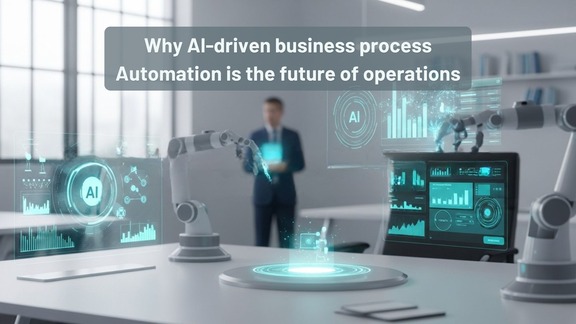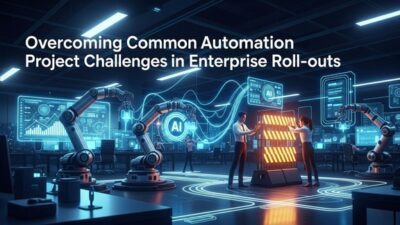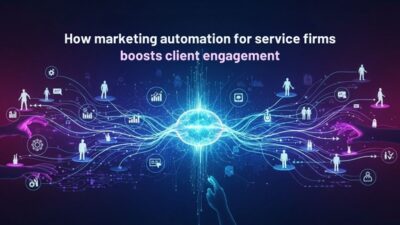Introduction
TL;DR The business world is changing fast. Companies struggle to keep up with rising customer expectations. Manual processes create bottlenecks that slow everything down. AI-driven business process automation offers a clear solution. This technology transforms how organizations operate from the ground up.
Traditional automation follows rigid rules. AI brings intelligence and adaptability to the table. Machines now learn from patterns and make decisions independently. Your team can focus on strategy while AI handles repetitive tasks. The shift represents a fundamental change in operational thinking.
Business leaders recognize they cannot ignore this trend. Competitors gain significant advantages through early adoption. The technology has matured beyond experimental phases. Real results show up in revenue, efficiency, and customer satisfaction metrics.
Table of Contents
Understanding AI-driven business process automation in modern enterprises
AI-driven business process automation combines machine learning with workflow optimization. The system analyzes data to improve processes without constant human intervention. Smart algorithms detect patterns that humans might miss entirely.
Your business generates massive amounts of data daily. Traditional tools cannot process this information effectively. AI systems digest complex datasets in seconds. They identify optimization opportunities across departments.
The technology works differently than older automation methods. Rule-based systems need explicit instructions for every scenario. AI adapts to new situations based on learned experiences. This flexibility makes it powerful for unpredictable business environments.
Core components that power intelligent automation
Machine learning algorithms form the backbone of these systems. They study historical data to predict future outcomes. Natural language processing enables computers to understand human communication. Computer vision allows machines to interpret visual information accurately.
These technologies work together seamlessly. A customer service platform might use all three simultaneously. The system reads emails, analyzes sentiment, and routes requests appropriately. No human needs to touch routine inquiries.
Integration capabilities determine system effectiveness. Modern platforms connect with existing software infrastructure. APIs enable data flow between different applications. Your current tools become more powerful through AI enhancement.
How AI differs from traditional automation approaches
Traditional automation executes predefined sequences without deviation. You program specific actions for specific triggers. The system breaks when situations fall outside programmed parameters.
AI-driven business process automation handles exceptions naturally. The system evaluates context before taking action. Learning algorithms improve performance through repeated exposure. Mistakes become training opportunities rather than system failures.
Scale represents another critical difference. Old automation required manual programming for each new process. AI systems scale horizontally across multiple operations. One deployment can optimize hundreds of workflows simultaneously.
Key benefits transforming operational efficiency
Companies implementing AI see immediate productivity improvements. Employees spend less time on mundane tasks. Error rates drop significantly across all departments. Cost savings appear within the first quarter of deployment.
The technology operates continuously without breaks or vacation time. Processing speed exceeds human capabilities by orders of magnitude. Complex calculations happen instantly. Your business can handle more volume without additional headcount.
Data-driven insights emerge from automated processes. AI tracks every interaction and outcome meticulously. Managers access real-time analytics for informed decision-making. Performance bottlenecks become visible and addressable.
Dramatic cost reduction across operations
Labor costs decrease when AI handles routine work. Companies redirect staff to higher-value activities. Overtime expenses vanish for many departments. The return on investment typically arrives within twelve months.
Error correction costs money in every industry. Manual data entry leads to expensive mistakes. AI-driven business process automation eliminates these errors systematically. Quality control becomes automatic rather than reactive.
Resource allocation improves through intelligent forecasting. AI predicts demand patterns with remarkable accuracy. Inventory management becomes optimized. Waste reduction translates directly to bottom-line savings.
Speed and accuracy that humans cannot match
Processing times shrink from hours to seconds. Document analysis happens instantaneously. Data extraction accuracy reaches near-perfect levels. Your customers notice faster response times immediately.
Consistency remains perfect across millions of transactions. Human performance varies based on numerous factors. AI maintains the same quality standards indefinitely. Regulatory compliance becomes easier to demonstrate.
Complex calculations prone to human error become reliable. Financial modeling incorporates thousands of variables simultaneously. Risk assessment happens in real-time. Decision quality improves across the organization.
Enhanced customer experiences through personalization
AI analyzes customer behavior patterns comprehensively. Systems predict preferences before customers express them. Personalized recommendations increase conversion rates significantly. Shopping experiences feel tailored to individual needs.
Response times for customer inquiries drop dramatically. Chatbots handle common questions instantly. Complex issues route to appropriate human specialists. Customer satisfaction scores improve measurably.
Service availability extends to true 24/7 operations. Time zones become irrelevant for global businesses. Peak demand periods no longer overwhelm support teams. Customer loyalty strengthens through consistent service quality.
Industries experiencing revolutionary transformation
Healthcare organizations use AI to improve patient outcomes. Diagnostic accuracy increases through image analysis. Treatment plans optimize based on massive datasets. Administrative burden decreases for medical professionals.
Financial services leverage AI for fraud detection. Suspicious transactions trigger immediate investigation. Loan approvals happen in minutes instead of days. Risk management becomes proactive rather than reactive.
Manufacturing plants optimize production through predictive maintenance. Equipment failures get predicted before they occur. Supply chains adjust automatically to changing conditions. Quality control happens at every production stage.
Financial services and banking innovation
Banks process loan applications using AI-driven business process automation. The system evaluates creditworthiness using hundreds of data points. Approval decisions happen instantly for qualified applicants. Default rates decrease through better risk assessment.
Fraud detection systems analyze transaction patterns continuously. Unusual activity triggers immediate alerts. False positives decrease through machine learning. Customer accounts remain protected around the clock.
Investment management benefits from algorithmic trading. Systems execute trades at optimal moments. Portfolio rebalancing happens automatically. Returns improve through data-driven decision making.
Healthcare and medical operations
Patient scheduling optimizes using predictive analytics. No-show rates decrease through intelligent reminder systems. Appointment availability matches patient needs better. Administrative staff focus on complex cases.
Medical imaging analysis happens faster with AI assistance. Radiologists review more cases with greater accuracy. Early disease detection rates improve. Treatment begins sooner for better outcomes.
Billing processes automate from claim submission through payment. Denial rates decrease through error checking. Revenue cycles accelerate significantly. Administrative costs drop substantially.
Manufacturing and supply chain management
Production lines adjust parameters in real-time. Quality issues get detected immediately. Defect rates plummet through continuous monitoring. Waste decreases across all production stages.
Inventory management becomes predictive rather than reactive. Stockouts decrease while carrying costs drop. Supplier performance gets tracked automatically. Procurement processes optimize continuously.
Logistics operations route shipments using AI algorithms. Delivery times improve through intelligent planning. Fuel costs decrease through optimized routing. Customer satisfaction rises with reliable deliveries.
Implementation strategies for successful adoption
Leadership commitment determines implementation success. Executives must champion the transformation actively. Budget allocation needs to reflect strategic priority. Company culture shifts to embrace technological change.
Start with processes that offer quick wins. High-volume repetitive tasks provide immediate value. Success stories build momentum for broader adoption. Team confidence grows through early victories.
Employee training requires significant investment. Staff need to understand new capabilities and limitations. Change management programs address resistance proactively. Communication remains transparent throughout the transition.
Assessing your organization’s readiness
Data infrastructure must support AI requirements. Systems need integration capabilities for smooth deployment. Legacy technology might require upgrades or replacement. Technical debt should be addressed early.
Organizational maturity affects implementation success. Companies need clear process documentation. Governance structures should exist before automation begins. Data quality determines system effectiveness.
Budget considerations extend beyond software licensing. Implementation costs include consulting and training. Ongoing maintenance requires dedicated resources. ROI calculations should be realistic and comprehensive.
Choosing the right AI automation platform
Vendor evaluation requires careful analysis. Look for proven track records in your industry. Reference customers provide valuable insights. Technical capabilities should match your requirements.
Integration abilities determine long-term success. Platforms must connect with existing systems seamlessly. API documentation should be comprehensive and clear. Support resources need to be readily available.
Scalability ensures the solution grows with your business. Cloud-based platforms offer flexible resource allocation. Licensing models should accommodate future expansion. Vendor stability matters for long-term partnerships.
Building internal expertise and capabilities
Training programs must cover technical and business aspects. Data scientists need to understand business context. Business users require technical literacy. Cross-functional teams drive the best outcomes.
Centers of excellence accelerate capability development. Dedicated teams focus on AI implementation. Best practices get documented and shared. Knowledge transfer happens systematically.
External partnerships supplement internal capabilities. Consultants provide specialized expertise. Technology vendors offer implementation support. Academic institutions contribute research insights.
Common challenges and proven solutions
Data quality issues undermine AI effectiveness. Garbage in equals garbage out in every case. Organizations must invest in data governance. Cleaning historical data requires significant effort.
Resistance to change creates implementation obstacles. Employees fear job displacement. Communication must address concerns honestly. Reskilling programs demonstrate commitment to workforce development.
Integration complexity slows deployment timelines. Legacy systems resist modern connectivity. Technical debt accumulates over years. Modernization initiatives require patience and resources.
Overcoming data quality and accessibility issues
Data silos prevent comprehensive analysis. Information lives in disconnected systems. Integration projects break down these barriers. Master data management becomes critical.
Inconsistent data formats complicate processing. Standardization requires organizational discipline. Data dictionaries bring clarity to definitions. Quality metrics track improvement over time.
Access controls balance security with usability. Permissions must support legitimate use cases. Compliance requirements constrain data sharing. Governance frameworks provide clear guidelines.
Managing change resistance and employee concerns
Transparent communication addresses fear directly. Leadership explains the vision clearly. Success stories highlight positive outcomes. Employee input shapes implementation approaches.
Reskilling programs prepare staff for new roles. Training investments demonstrate long-term commitment. Career paths evolve rather than disappear. Opportunities emerge for those who adapt.
Pilot programs prove value before full deployment. Small wins build credibility incrementally. Feedback loops enable course correction. Momentum builds through demonstrated success.
Addressing security and compliance requirements
AI systems must protect sensitive data rigorously. Encryption safeguards information at rest and in transit. Access logs provide audit trails. Security reviews happen regularly.
Regulatory compliance varies by industry and geography. Healthcare has HIPAA requirements. Finance follows strict reporting rules. Legal teams must review all implementations.
Ethical considerations guide AI deployment. Bias in algorithms creates legal liability. Fairness metrics monitor system behavior. Human oversight prevents automated discrimination.
Measuring ROI and performance metrics
Success metrics must be defined before implementation. Quantitative measures track efficiency gains. Qualitative assessments capture user satisfaction. Baseline measurements enable comparison.
Time savings represent the most obvious benefit. Track hours eliminated from specific processes. Calculate salary costs for those hours. Multiply by number of affected employees.
Error reduction translates to concrete savings. Quantify the cost of mistakes in your context. Measure error rates before and after automation. Calculate the difference in financial terms.
Financial metrics that demonstrate value
Direct cost savings appear in multiple categories. Labor costs decrease through productivity gains. Error correction expenses vanish. Overtime requirements evaporate.
Revenue improvements result from faster processes. Sales cycles compress through automation. Customer acquisition costs drop. Lifetime value increases through better service.
Working capital optimization frees trapped resources. Accounts receivable cycles accelerate. Inventory turnover improves. Cash flow strengthens across the board.
Operational efficiency indicators
Processing time reductions show up immediately. Compare cycle times before and after deployment. Track improvements across multiple processes. Document speed gains systematically.
Throughput capacity increases without additional resources. Systems handle higher volumes effortlessly. Scalability becomes elastic and automatic. Growth no longer requires proportional cost increases.
Quality metrics demonstrate accuracy improvements. Defect rates drop to near zero. Rework requirements disappear. Consistency reaches new levels.
Customer satisfaction improvements
Response time metrics show dramatic improvement. Customer inquiries get answered instantly. Issue resolution accelerates significantly. Wait times become minimal.
Net Promoter Scores reflect better experiences. Customer satisfaction ratings climb. Complaint volumes decrease. Loyalty indicators strengthen.
Retention rates improve through superior service. Churn decreases across customer segments. Lifetime value calculations shift favorably. Acquisition costs justify themselves faster.
Future trends shaping automation evolution
AI capabilities continue advancing rapidly. Models become more sophisticated monthly. Accuracy improves across all use cases. Costs decrease as technology matures.
Generative AI adds creative capabilities to automation. Content creation scales infinitely. Personalization reaches unprecedented levels. Human creativity gets amplified rather than replaced.
Edge computing brings AI closer to data sources. Processing happens locally for faster response. Privacy concerns diminish through distributed architecture. Reliability improves through reduced cloud dependence.
Emerging technologies and capabilities
Quantum computing will revolutionize AI processing. Complex calculations become trivial. Optimization problems get solved instantly. Current limitations disappear entirely.
Augmented intelligence combines human and machine strengths. Humans handle judgment while AI processes data. Collaboration produces better outcomes than either alone. Workforce capabilities multiply exponentially.
Autonomous systems operate with minimal supervision. Self-healing processes fix issues automatically. Continuous improvement happens without intervention. Organizations approach true lights-out operations.
Predictions for the next five years
AI-driven business process automation becomes universal across industries. Competitive pressure forces adoption. Laggards struggle to survive. Technology barriers continue falling.
Smaller businesses access enterprise-grade capabilities. Cloud platforms democratize advanced tools. Implementation becomes simpler and faster. Cost structures favor rapid adoption.
Workforce composition shifts dramatically. Routine jobs evolve or disappear. New roles emerge around AI management. Skills requirements change fundamentally.
Preparing your business for what’s next
Continuous learning becomes organizational imperative. Technology evolution never stops. Adaptation determines survival. Investment in capabilities must be ongoing.
Strategic planning incorporates AI centrally. Technology shapes business models fundamentally. Innovation cycles accelerate continuously. Agility becomes more valuable than stability.
Partnership ecosystems expand and deepen. No single vendor provides complete solutions. Integration capabilities remain critical. Collaboration determines competitive advantage.
Read More:-Unlock Enterprise Growth with AI-Driven Business Process Automation
Conclusion

AI-driven business process automation represents an unstoppable force in modern business. Organizations embracing this technology gain enormous competitive advantages. Early adopters see immediate returns across multiple dimensions.
The future belongs to companies that transform operations through intelligent automation. Speed and accuracy reach levels impossible through human effort alone. Costs decrease while quality and customer satisfaction soar.
Your business faces a clear choice. Implement AI-driven business process automation now and lead your industry. Wait and watch competitors pull ahead irreversibly. The window for competitive advantage remains open but narrows daily.
Start small with high-impact processes. Build momentum through demonstrated success. Scale systematically across your organization. The journey requires commitment but delivers transformative results.
AI-driven business process automation is not coming someday. It exists now and delivers measurable value immediately. Your operational future depends on acting decisively today. The technology has arrived and proven itself thoroughly.





